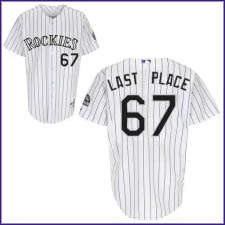Colorado may not be the worst team in the National League, but they may be the dullest. Florida’s incendiary brand of roster management at least has a macabre entertainment value. In contrast, the Rockies lethargically trudge toward utter pointlessness.
This team is bad. So, instead of prattling on about whether Cory Sullivan can “take it to the next level,” I’d like to discuss what Colorado can do, if anything, to win in the future. If that doesn’t entice you to click the “[More]” link below, I also have a picture of two adorable cats.
You may remember them from last year:
How Bad Are The Rockies?
For much of the season, Colorado played much worse than their grim total of 67 wins would suggest. The Rockies lost 21 of their first 27 games. Only nine teams in MLB history have started worse. They batted .232/.299/.359 on the road and lost forty of their first fifty games away from Coors. On August 19th they had a record of 45-77, on pace to lose 103. Some respectable late-season play salvaged a tie with the inaugural squad of 1993 for the worst record in franchise history.
Colorado performed one task well: they held opponents to a reasonable 5.5 runs per game at Coors Field (an average team would allow about 5.9). Unfortunately, they only scored 5.6 runs per game at home. Outside of Denver, they managed 27 wins, awful and yet par for the course. The Rockies haven’t exceeded thirty road wins since 2000.
An Offensive Lineup
Player Pos Age Bat OBP OBP+ SLG SLG+ C Barmes SS 27 R .330 93 .434 98 C Sullivan CF 26 L .343 97 .386 87 T Helton 1B 32 L .445 126 .534 120 M Holliday LF 26 R .361 102 .505 114 G Atkins 3B 26 R .347 98 .426 96 B Hawpe RF 27 L .350 99 .403 91 L Gonzalez 2B 27 R .333 94 .421 95 Y Torrealba C 27 R .297 89 .338 80
Excluding strike-ruined 1994, the Rockies scored a franchise-worst 740 runs per game last season. An average-hitting team Denver would have scored about 835. Only two of the Colorado’s eight projected starters reached base or slugged better than a league-average level last year. All but Helton are either 26 or 27 years old, and a lingering back injury marred Helton’s 2005, so they do have room for improvement. Still, they project to have a below-average offense. At least half of the players listed above won’t be regulars within two years.
Given their current pitching, how many runs does Colorado need to score to compete for the postseason? Joe Sheehan of Baseball Prospectus suggested as many as 1,250 in a chat session in February of 2005. He later amended his answer to 1,150, then said that “if the Rockies aren’t scoring a thousand runs, they can’t win.” He recommended a scorched-earth policy of roster construction consisting of a “ridiculous offense” and “treat[ing] their pitchers as fungible.”
Let’s try to answer the question with more precision. Colorado has allowed about 5% more runs than an average team (league and park-adjusted) during the past first years. Using last year’s league and park factor, that’s about 875 runs. Also assume the Rockies need ninety wins to have a respectable chance at the postseason. Plugging the numbers into the theorem developed by noted baseball fanatic Pythagoras reveals that the Rockies need to score about 980 runs to win ninety games, given 875 runs allowed. 980 runs is below what Sheehan recommended, but league-wide offense declined in 2005 and Coors Field no longer inflates offense as much as in years past. Ninety wins don’t guarantee October baseball, of course, but they do give fans a reason to show up. Attendance has declined 50% over the last seven years.
980 runs. Colorado plated 968 in 2000 and 961 in 1996, when the league and park favored offense much more heavily. Scoring 980 now is a much tougher task, but it’s not an outrageous or even unreasonable number.
What kind of batting line does Colorado need to score 980 runs? In predicting such things, I’ve developed a formula based on regressing a variety of offensive factors such as average, OBP, slugging, and even steals and caught-stealing, which play a small but statistically significant role. I don’t want to put you to sleep with too many numbers, so suffice it to say that the formula works well (email me if you’re interested). Colorado scored 740 runs last year, and my formula predicted 750.
If Colorado hits .280/.360/.490 and doesn’t act stupidly on the basepaths, they could score 984 runs, a smidgen more than they need to wins ninety games with their existing pitching. A .360 OBP would place them among the top 2% in NL history, and a .490 slugging percentage would surpass their own NL record of .483. Still, if any team has the potential to achieve this level of output, it’s Colorado.
Understand that I refer to Colorado’s offensive potential in the abstract sense. Certainly, the present collective won’t attain 980 runs. Colorado scored a meager 740 runs last season and is essentially relying on internal improvement to tally another 240. Good luck with that.
Incidentally, for 1,250 runs Colorado needs a line of about .310/.390/.550. That’s a team OPS+ of 134.
Pitchers and Perseverance
Rotation Arm Age ERA ERA+ HR% BB% SO% J Francis L 25 5.68 86 3.1% 8% 14% A Cook R 27 3.67 133 2.2% 4% 7% J Jennings R 27 5.02 97 2.0% 11% 14% B Kim R 27 4.86 100 2.5% 11% 17% J Fogg R 29 5.05 83 3.6% 6% 11% Z Day R 28 6.85 61 2.6% 14% 10% S Kim R 28 4.90 93 2.8% 6% 15%
Bullpen Arm Age ERA ERA+ HR% BB% SO% B Fuentes L 30 2.91 167 1.9% 11% 28% M DeJean R 35 3.19 152 0.0% 8% 23% R King L 32 3.38 132 2.3% 9% 13% D Cortes R 32 4.10 119 4.2% 5% 17% S Dohmann R 28 6.10 80 4.2% 13% 24% J Acevedo R 28 6.47 75 4.5% 5% 11% K Yabu R 37 4.50 99 2.3% 10% 17% J Mesa R 40 4.76 88 2.7% 10% 14%
Predicting the performance of Colorado pitchers assures failure. Rockie hurlers show a total lack of correlation in year-to-year performance, partly because the park invites high variance and partly because most of them haven’t been very good. A review of the ten Colorado pitchers who qualified for the ERA title with the best ERA+ and their follow-up performances:
Joe Kennedy, 2004: 162 IP, 3.66 ERA , 138 ERA+
Next Year: 7.04 ERA in 92 innings (67 ERA+), traded in July to Oakland for Eric Byrnes, Omar Quintanilla and cash.
Kevin Ritz, 1995: 173 IP, 4.21 ERA, 127 ERA+
Next year: 213 innings in 35 starts, ERA up to 5.28, 103 ERA+
Brian Bohanon, 2000: 177 IP, 4.68 ERA, 127 ERA+
Next Year: 97 innings, 7.14 ERA (73 ERA+), did not pitch in the Majors afterwards
Armando Reynoso, 1993: 189 IP, 4.00 ERA, 123 ERA+
Next year: only nine starts and 52 innings pitched, 4.82 ERA, 103 ERA+
Roger Bailey, 1997: 191 innings, 4.29 ERA, 121 ERA+
Next Year: Suffered multiple injuries in an auto wreck and never again pitched in the Majors.
Pedro Astacio, 1999: 232 IP, 5.04 ERA, 114 ERA+
Next Year: 196 IP, 5.27 ERA, 113 ERA+ (see below)
Pedro Astacio, 2000: 196 IP, 5.27 ERA, 113 ERA+
Next Year: 141 IP with Colorado, 5.49 ERA, 95 ERA+, traded to Houston in July for Scott Elarton.
John Thomson, 1997: 166 IP, 4.71 ERA, 110 ERA+
Next Year: essentially identical line of 161 innings, 4.81 ERA, 106 ERA+
Armando Reynoso, 1996: 169 IP, 4.96 ERA, 110 ERA+
Next Year: pitched poorly for the Mets, only sixteen starts
Jason Jennings, 2002: 185 IP, 4.52 ERA, 108 ERA+
Next Year: similar number of innings, 5.11 ERA, 93 ERA+
Next Year In Sum:
Qualified for ERA title, above-average ERA+: 2
Qualified for ERA title, below-average ERA+: 2
Did not qualify for ERA title, above-average ERA+: 2
Did not qualify for ERA title, below-average ERA+: 3
Did not pitch: 1
This analysis is hardly scientific but does reveal the folly of predicting a repeat of a good performance from any Rockie pitcher. Six of the ten didn’t reach 162 innings the following year (though Thomson missed by the slightest of margins), and only four managed better than a 100 ERA+ regardless of innings pitched.
The thin air destroys everyone eventually, in body or spirit. No Colorado pitcher has five consecutive years of 100-plus innings. Jason Jennings will attempt to become the first this season. The Hall Of Fame will waive the five-year rule if he succeeds. Perhaps the Rockies should immediately trade any pitcher who has a good season.
Colorado does have some talent in its rotation. Young Jeff Francis survived his first full season without completely flaming out. Strangely, Coors Field did not stipulate his 5.68 ERA. At home, Francis had a reasonable 4.88 ERA with acceptable peripherals. Conversely, he allowed seventeen of his 26 homers on the road and his ERA ballooned to 6.40. Aaron Cook pitched well after missing nearly a year because of blood clots in his lungs that required removal of a rib. Cook doesn’t strike out anybody and walks too many, but he keeps doubles and homers to a minimum with a terrific grounder-inducing two-seamer. Byung-Hyun Kim revived his career in Colorado, posting a 4.37 ERA with acceptable peripherals as a starter. Jason Jennings may never recapture his Rookie-Of-The-Year performance of 2002, but he can eat innings with nearly a league-average ERA.
Likewise, the Rockie bullpen has an adequate front four in Brian Fuentes, Mike DeJean, David Cortes and Ray King. A suspect back end (Jose Mesa, Jose Acevedo, Keiichi Yabu, the batboy, your brother-in-law David) will cause problems. Interestingly, I would have expected Colorado to need many more pitchers than their competitors, but history indicates otherwise. From 2000-2005, the other fifteen NL teams had an average of 18.6 pitchers throw at least ten innings in any given season. Colorado used an average of twenty. That is higher, of course, but inferior pitching and late-season call-ups for meaningless games could be partial reasons in addition to the thin air.
Charles In Charge
Last February, Club CEO Charlie Monfort signed general manager Dan O’Dowd and manager Clint Hurdle through 2007. As repoted by MLB.com’s Thomas Harding, he credited them with “pulling the franchise out of a hole… more serious than being below .500.” The hole appeared when Colorado signed Mike Hampton and Denny Neagle to $172.5 million in contracts but continued to lose on the field and in the stands. Per Monfort, “we lost well over $50 million on contracts that weren’t successful. When you’re losing money and your team is no good, that to me is a crisis… That’s been our loyalty to Dan because he did get us out of those contracts. Dan, I think, did a fantastic job there.”
To answer your question: the GM who signed Hampton and Neagle was Dan O’Dowd.
Monfort proclaimed that the Rockies could win the NL West. He also said the Rockies could win the Powerball lottery and a pony. If you’re going to wish, wish big.
Outlook
Despite all my snark, I believe the Rockies can contend for the NL West as early as 2007. If Ryan Shealy and Jeff Baker progress as hoped and the team signs a couple of big bats to replace the dross in the lineup, Colorado could make some noise. Management acumen will play a large role in this resuscitation, and, well, there you may have a problem.
As for this season? 67 wins again. No pony.






